Abstract
Learning about ecosystems is challenging because, like any complex system, they are simultaneously multidimensional and dynamic. Often, learners engage only with the visible components of an ecosystem and draw either single or linear causal connections between components. In this study, we explored how using a Structure-Behavior-Function framework supported middle school students’ conceptual and complex reasoning about the visible and invisible components of an ecosystem. Research shows that learners often engage only with the visible components of an ecosystem and draw linear/single causal connections between the components of the ecosystem. Our findings suggest that a combination of using structure, behavior, and function approach along with a set of carefully designed technology tools can push the students toward a better understanding of the ecosystem functioning. The results show that along with the visible components of the ecosystem, students have started to identify the invisible components of the ecosystem.
